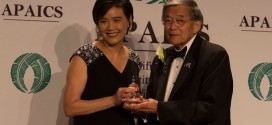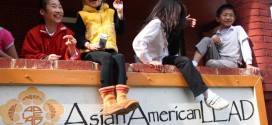By Jenny Chen
In May 2014, the Newseum debuted a surprisingly different take on media with their “One Nation with News for All” exhibit. The exhibit, which takes a close look at ethnic media in the United States, is the first collaboration between the Smithsonian and the Newseum. According to Jim Deutsch, program curator with the Smithsonian Center for Folklife and Cultural Heritage, the two organizations began talking about a possible partnership for the Smithsonian’s “Our American Journey” initiative last April. With the Smithsonian trove of artifacts and the Newseum group of experts, “it was kind of just a match waiting to be made,” Deutsch said. Smithsonian curator Sojin Kim also helped Deutsch with the exhibit.

Today, “One Nation with News for All” draws visitors from all over the country who take selfies at the exhibit entrance which features a mosaic of head shots of ordinary people from Washington, D.C. Inside the main exhibit those photos hang from the ceiling like leaves of a tree. The tree motif is the brain child exhibit designer Jeannine Lockwood who racked her brains for months to find something that wasn’t cliche but was profound at the same time. “It was difficult because there wasn’t a time period or a person that the exhibit was about,” Lockwood said.
It was only after Lockwood spied a photo in National Geographic of a person looking outwards in a forest of trees that she struck upon the metaphor of the tree. Lockwood said it was the perfect way to bring all the disparate stories together and say, “As individuals we’re strong but together we form a beautiful canopy.”

Sharon Shahid, the lead exhibit writer, faced similar challenges in distilling years of history in ethnic media to a manageable and understandable flow. “We left a lot on the cutting room floor,” Shahid said.
In the end, the team decided to include the firsts, the pioneers and the innovators. “We tried to include stories that were representative,” said Shahid. The result is an exhibit that showcases a diverse group of stories such as that of Benjamin Franklin’s German language paper Zeitung, Bill Hosokawa’s The Heart Mountain Sentinel, and the first Asian American paper Golden Hills News. To represent the myriad of voices that were not included in the main exhibit, the Newseum installed a wall of 10 changing newspaper front pages from ethnic media outlets across the country. There are also banners of front covers along the hallway leading up to the exhibit – indicating just how vibrant and rich the tradition of ethnic media is in the United States.

The exhibit also features an interactive component with a short documentary video explaining the importance of ethnic media in contemporary America. Next to the video there are highlights of contemporary ethnic newsmakers including Angry Asian Man blogger Phil Yu.
Shahid said that the exhibit has brought in a different demographic of visitors to the Newseum. “We usually get a lot of school children…but sometimes when I go up to the exhibit to answer questions, I’m always awed by the diversity of visitors,” she said. The fact that the exhibit seems to strike a chord with visitors is no surprise since, according to the New America Media Foundation which provided the Newseum with a lot of their statistics for the exhibit, 25% of Americans turn to ethnic media for their news. The more than 3,000 media outlets include about 1,200 newspapers. The top three categories are Latino (979), Asian (592) and African American (479). Languages in media outlets run from Amharic to Hmong to Yiddish.
The exhibit took about a year to complete and will be on display until Jan. 4, 2015. More information is available at www.newseum.org
Editor’s Note: Asian Fortune is among one of the news outlets featured in the exhibit. Come see us!
 Asian Fortune Your source for all things Asian American
Asian Fortune Your source for all things Asian American


